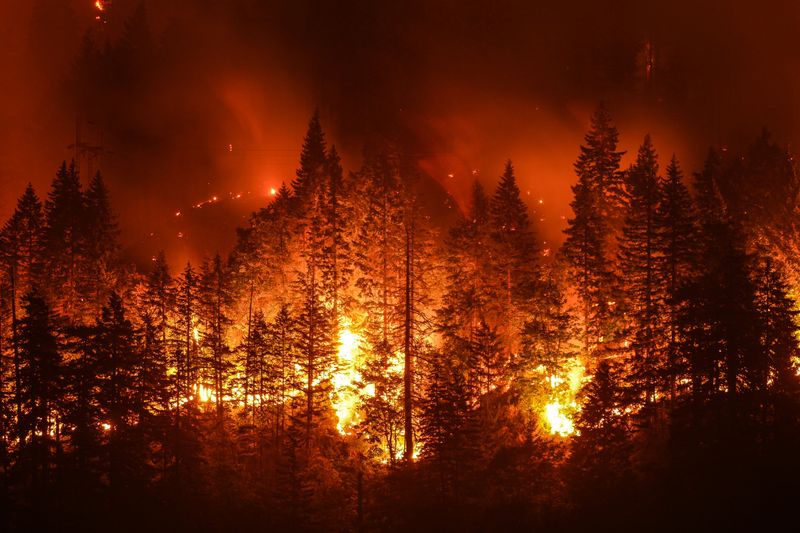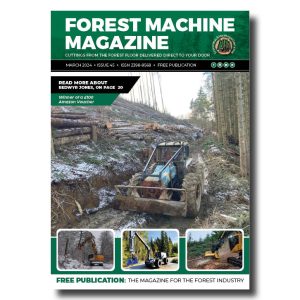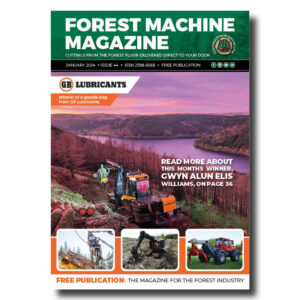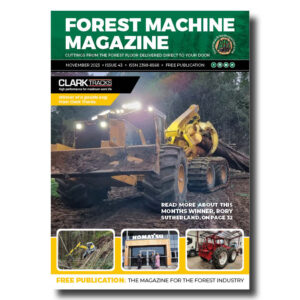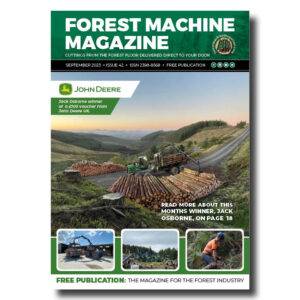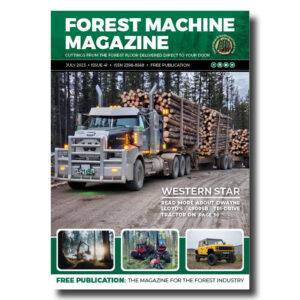With the warm dry weather set to continue this weekend we will see a fire danger extreme situation where the utmost care must be taken to prevent forest and wild fires.
Fire danger extreme-Like everything though the good weather comes at a cost, and with a dry spring and early summer this can be hazardous for forest plantations and creates an extreme level of fire danger.

-
That’s a remarkable amount of work hours for a single machine, the Norcar 600 owned by Erkki Rinne is taken well care of, it even has the original Diesel engine.
-
Kieran Anders is a forestry contractor working in the lake district. His work involves hand cutting and extracting timber using a skidder and tractor-trailer forwarder.
-
It is not possible to eliminate chain shot, but there are simple steps that can be taken to reduce the risk.
-
Arwel takes great pride in the fact that the mill has no waste whatsoever, “the peelings are used for children’s playgrounds, gardens and for farm animals in barns in the winter and the sawdust has multiple uses in gardens and farms as well.
-
Timber hauliers need to encourage young blood in, and also look after the hauliers we have, we need make the sector a safe and positive place to work.
FIND US ON
Related Posts
This year has been disastrous, with dry conditions increasing the risk. Lightning strikes are identified as the cause of many fires. In the UK, the risk has surged this week as warm, dry weather continues.
A state of emergency has been declared in the USA, South Korea, Croatia, and India due to devastating fires that have severely impacted forests, wildlife, and properties.
The UK has recorded its second-worst year for wildfires, with 25,000 acres burned to date, and this number is expected to rise as the dry weather persists.
These fires recall my time in the late 1970s and early 1980s when I worked as a chainsaw operator for the Forestry Commission in Beddgelert, North Wales.
The first fire I responded to occurred at the end of a sweltering workday after we had been felling and snedding trees for skidder extraction on a piecework basis, and I was quite exhausted. We received a call over the van radio about a forest fire in the Llyn Peninsula, a three-quarters of an hour drive away. I distinctly remember it was Thursday; we had just received our wages, and our Foreman, Wyn Williams, suggested we tuck our money inside our boots for safekeeping. We set off with two Leyland Sherpa vans packed with chainsaw operators to assist our forestry colleagues in the area district.
As we drove up a forest road, we discovered the fire was about a mile from a safe parking spot for our van. We felt hot and exhausted, and climbing the mountain to reach the fire source seemed intimidating, especially since we needed to carry our chainsaws, fuel, and felling equipment.
Despite our fatigue, we tried to create some firebreaks to help contain the blaze; luckily, a skidder was on-site to drag the felled timber out of the way, which further aided in reducing the fire’s spread.
Forest fires are frightening because you face two major threats: the smouldering peat beneath you, which requires firefighters with beaters to manage, and the crown fire, which can expand quickly and unpredictably, driven by the wind. The ground fire ignites trees one by one, causing them to explode as the flames race up the highly flammable needles to reach the crown. This occurs in seconds, generating unbearable heat, so much so that even seasoned firefighting professionals remain cautious around forest fires.

We finished cutting the fire breaks at around 11pm, at which point we were felling trees in the dark with only the skidders’ headlamps for illumination. We were all exhausted, tired, starving, and thirsty.
My dad, who operated the campsite at Beddgelert, had prepared some sandwiches, flasks of tea, and cold drinks and sent them down; unfortunately, they never reached our group. Many men from various forest districts participated, and we were covering a vast area, but still, we were absolutely starving.
That night was spent managing hotspots that flared up on the ground with beaters, as fortunately, the wind had calmed. Another concern we had to be vigilant about was adders, as this area is a sanctuary for snakes. While we were tackling the fires directly, they were attempting to escape the flames by coming through us. Sadly, they did not understand that we were trying to help them, resulting in a couple of guys getting bitten and needing hospital treatment.
As dawn broke, our relief team arrived, and we staggered down the mountain with our exhausted bodies and felling equipment to our vehicles. Although we stayed two more nights at the fire, our work involved preventing flare-ups, as we had successfully contained the blaze, preserving a significant area of mature timber.
It was two years before another major fire occurred, this time near a small village close to Penrhyndeudraeth. I received the call around 11pm after having attended an all-day wedding, leaving me in less than ideal shape. Not being there was not an option then, so my parents pumped me full of a couple of gallons of coffee to counteract the alcohol, helped get me dressed, and ensured that I was coherent and steady by the time my ride arrived
This fire broke out in a young plantation and was suspected to have been ignited by the train on the Ffestiniog Railway since it followed another dry spring, and the steam train used wood as fuel.
Hathaway water pumps were used in tandem to transport water to the fire, so our work involved carrying pumps, hoses, and water butts through the young trees. As daylight arrived, I received some strange looks from my colleagues, and it was only when I got to the van that I noticed, in my enthusiasm to get water hoses to each section by pushing through the young Sitka Spruce, I’d been left with scratches and dried blood on my arms and face. Adding my bloodshot eyes to this (nb this was the first time I have experienced the full development of a hangover; up to then, I would go to bed after drinking and wake up hungover) and black charcoal from the charred trees, you will get the picture.
We had another couple of days there, and once we got the all-clear, we returned to our timber harvesting duties, leaving the forestry maintenance squad to prevent further flare-ups.
However, after just a couple more days of felling, we received a call to attend a huge fire in Gwydyr Forest near Betws Y Coed. We were all apprehensive about going, as the word was that it was out of control and that over 100 FC staff, foresters, the Fire Brigade, and the Royal Engineers were already in attendance.
This was the biggest and worst fire I have ever experienced, as the weather was hot and dry, with a constant breeze providing perfect conditions for the fire to spread. The large town of Betws Y Coed (Chapel in the Trees) was within range of the fire, which was a crucial concern for the authorities.
It was absolute chaos on our arrival; there was no one in overall charge, and all the chainsaw guys were being ordered around everywhere. We were incredibly lucky that our forester, Dave Whitmarsh, was with us because he was the perfect level-headed person to have in such a situation. He told us to ignore everyone and to take our instructions from him, as he would liaise with the Fire Chief to see where we could be deployed most effectively.
Our initial objective involved taking our saws and gear down a steep ride to fell some mature Sitka Spruce to create a bigger fire break. Five of us were doing this with myself at the very bottom and my colleague Owie Jones was positioned above me. We kept a safe distance while felling, and after about an hour, I noticed our Skidder Operator, Clifford Jones, waving from the road at the top of the slope. Cliff, known for his jokes, made me wave back as I continued working. However, he was trying to alert us that the crown fire had shifted direction due to the wind and was now moving toward us. It was only when I felled a tree and noticed sparks and smoke swirling off its top upon impact that I realised we were in danger.
Fortunately, all my colleagues had witnessed this as well and were quickly fleeing up the slope to safety. Owie and I had the greatest distance to cover up the steep incline with our saws and equipment. About halfway up, we were surrounded by thick smoke, and panic truly set in. It was terrifying, feeling almost unable to breathe or see while effectively running for our lives. We eventually reached the top, and it felt like my lungs were on fire; I thought my heart was going to burst out of my chest.
After some time, we were finally able to breathe normally, though my entire body trembled with a mix of fear and joy—the area we had been working in was on fire. The wind had intensified significantly, rendering the fire break ineffective, and the trees we had cut down had caught fire as well.
The rest of that day felt hazy, but we finished our 12-hour shift and were sent home for a 12-hour break before returning. This 12 hours on, 12 hours off schedule continued for the next ten days.
On our third day, a Fire Tender’s gearbox malfunctioned. After moving it out of the way, the Royal Engineers began removing the gearbox. I have never witnessed such a well-organised process; they had a mobile workshop with one person inside and another outside, while a mechanic worked on the Fire Tender

Every tool used was promptly returned to the van after it was no longer necessary, and the entire replacement took them just under three hours gearbox. The Fire Chief was astonished as normally the Fire Tender would have been out of commission for at least three weeks.
Each day, we continued cutting fire breaks and gradually gained some control over the fire. In addition to the Fire Tenders, several Green Goddess Fire Tenders staffed by Royal Engineers were also present. The fire was significantly more intense during the day, as the wind usually calmed down at night.
The WRVS (Women’s Royal Voluntary Service) did an excellent job of ensuring everyone remained fed and hydrated, a task that must have felt endless.
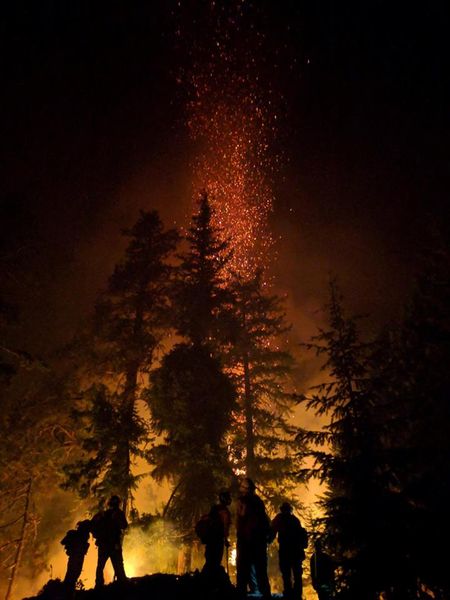
On the fourth day, I was collaborating with my colleague, Mike Tranter, to fell trees along the edge of a forest road to establish yet another fire break. I was felling the trees while Mike pushed them over, and we were making impressive progress.
Amidst the chaos, I was not focusing on my work as much as I should have. I had just made the front cut on a large tree and was finishing the back cut when a military Land Rover sped up the road and stopped next to us. Unfortunately, I had cut too deeply into the hinge on the forest side, resulting in heavier branches on the roadside than I expected.
The tree had reached a point of no return, with the hinge tearing apart as it fell toward the Land Rover. Thankfully, Mike anticipated this and was yelling at the Royal Engineers who had jumped out of the back of the soft top in record time.
My tree struck the soft top perfectly and flattened it. I felt a wave of relief, believing I had not hurt anyone- or so I thought.
The Royal Engineers realised one of their team was missing, so we quickly started cutting the tree into sections for removal from the back of the Land Rover. The final Royal Engineer scrambled out of the back, shaken but fortunately uninjured.
The next day, every vehicle involved in the fire was equipped with a hard top canopy!
We were now winning the battle, which was important since everyone was exhausted; the continuous 12-hour shifts on chainsaws were certainly taking a toll on everyone involved.
At this stage, the media had begun to focus on the fire, and I found myself featured on the BBC’s Nationwide news programme, as well as in the Daily Post and Daily Mail newspapers. It was a tremendous relief for all of us when the rain finally arrived, allowing us to return to normal working conditions.
Our forester, Dave Whitmarsh, was exceptional; we were working days, which meant we had eight hours at regular pay and four hours at overtime, while the night shift crew had far fewer tasks (no chainsaw work) but earned double time. Consequently, Dave compensated us with double time for the 12 hours worked and half time for the 12 hours off, as he believed we deserved extra pay for our hard work.
The FC in Wales had the foresight to surround all the smallholdings within the forest with Larch trees, thus allowing the grass and bracken to grow under the canopy and creating a natural fire break.
Although I have attended a few minor fires since, fortunately, they were contained easily.
Massive forest fires have led to some of the most terrifying and distressing experiences of my life, inflicting severe damage on local communities and resulting in a significant waste of precious timber.
Drones can play a crucial role in managing forest fires; they can be equipped with heat sensors to spot potential hot spots that could reignite. They serve as invaluable tools for assessing the direction, size, and speed of the fire’s spread, which can be lifesaving for those on the ground.
We extend our admiration to all the courageous men and women who have faced the devastating fires we have witnessed globally this year; they truly risk their lives to protect us.
We express our deepest condolences to those who have lost loved ones, homes, livelihoods, and belongings.
Sadly, forest fires do not have a conscience
Contact forestmachinemagazine@mail.com to get your products and services seen on the world’s largest professional forestry online news network.
#homeoflogging #writtenbyloggersforloggers #loggingallovertheworld
Written by loggers for loggers and dedicated solely to the equipment used in forestry operations.

